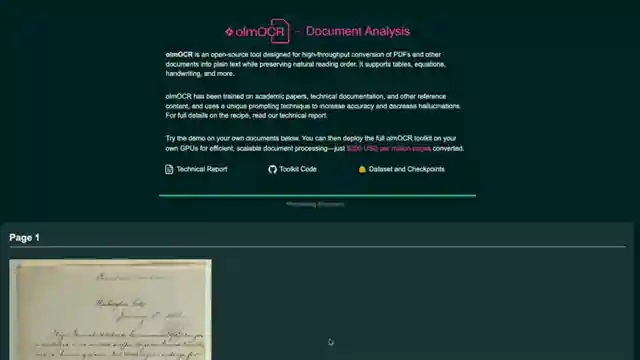Unleashing Ln AI's M OCR: Revolutionizing PDF Data Extraction

- Authors
- Published on
- Published on
In this thrilling episode, Sam Witteveen delves into the revolutionary M OCR model by the brilliant minds at Ln AI. This cutting-edge technology aims to tackle the age-old challenge of converting PDFs into a format compatible with llms. The team at Ln AI, known for their commitment to openness, have fine-tuned the M OCR model based on the powerful quen 2 VL 7B instruct model. This means handling everything from handwriting to equations with ease, setting a new standard in OCR capabilities.
What sets Ln AI apart is their dedication to sharing not just the models and data, but also the code used for training, along with detailed papers outlining their groundbreaking methodologies. The M OCR model has been making waves in the tech world, surpassing other open-source models like Mara and Miner U with its exceptional performance. Users can even test the model themselves through an interactive demo, allowing them to upload and process up to 10 pages of their own documents.
To run this state-of-the-art model, you'll need a powerful GPU and the necessary utilities like SG Lang and the Transformers library. By following the setup for the quen 2 VL model, users can seamlessly process PDFs by rendering them into images and extracting text with remarkable accuracy. The model's output includes natural text with markdown formatting and table support, making it a game-changer for local data processing. Ln AI's M OCR offers a convenient on-premises solution for converting PDFs efficiently, providing a compelling alternative to cloud-based services. Viewers are encouraged to dive into this exciting technology, share their experiences, and stay tuned for more thrilling updates from the channel.

Image copyright Youtube

Image copyright Youtube

Image copyright Youtube

Image copyright Youtube
Watch olmOCR - The Open OCR System on Youtube
Viewer Reactions for olmOCR - The Open OCR System
Gemini (flash 2) is good for most use cases, with surprising bounding boxes
Rapid OCR based on paddle paddle is considered the best OCR with millisecond load time
Concerns about security and PDF access in LLM environment (FEDRAMP)
Question about using API for LLMs like Gemini and Claude instead of local solutions
Interest in extracting data from graphs/charts from medical publications using olmOCR
Inquiry about availability of OCR as an API
Question about OCR for Japanese language
Concerns about handling tables properly, especially with multiple rows of headings
Questioning the need for redundant work with other OCR models available
Request for Arabic text extraction from PDFs
Related Articles

Unleashing Gemini CLI: Google's Free AI Coding Tool
Discover the Gemini CLI by Google and the Gemini team. This free tool offers 60 requests per minute and 1,000 requests per day, empowering users with AI-assisted coding capabilities. Explore its features, from grounding prompts in Google Search to using various MCPS for seamless project management.

Nanet's OCR Small: Advanced Features for Specialized Document Processing
Nanet's OCR Small, based on Quen 2.5VL, offers advanced features like equation recognition, signature detection, and table extraction. This model excels in specialized OCR tasks, showcasing superior performance and versatility in document processing.

Revolutionizing Language Processing: Quen's Flexible Text Embeddings
Quen introduces cutting-edge text embeddings on HuggingFace, offering flexibility and customization. Ranging from 6B to 8B in size, these models excel in benchmarks and support instruction-based embeddings and reranking. Accessible for local or cloud use, Quen's models pave the way for efficient and dynamic language processing.

Unleashing Chatterbox TTS: Voice Cloning & Emotion Control Revolution
Discover Resemble AI's Chatterbox TTS model, revolutionizing voice cloning and emotion control with 500M parameters. Easily clone voices, adjust emotion levels, and verify authenticity with watermarks. A versatile and user-friendly tool for personalized audio content creation.
